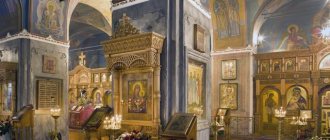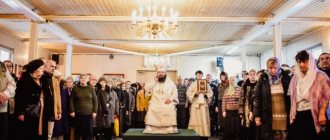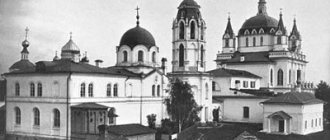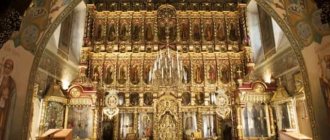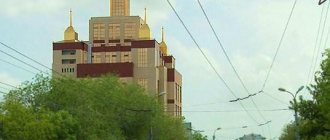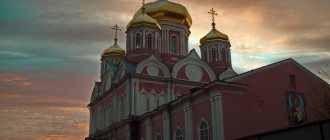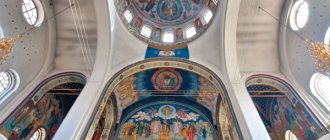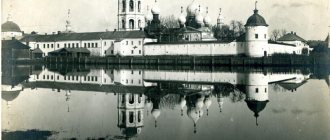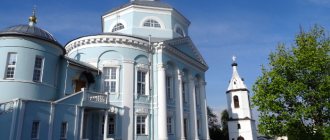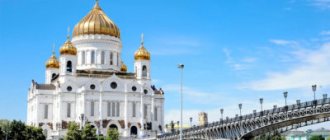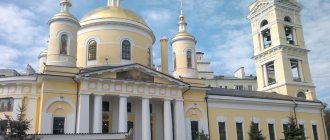| Novgorod St. Sophia Cathedral |
Novgorod and Old Russian Diocese of
the Novgorod Metropolis of the Russian Orthodox Church
- Diocesan administration: Russia, 173000, Veliky Novgorod, st. Slavnaya, 12
- Tel.; fax: 63-33-42
- Official site:
- Canonical territory: Veliky Novgorod, Batetsky, Valdai, Volotovsky, Demyansky, Krestetsky, Malovishersky, Marevsky, Novgorod, Parfinsky, Poddorsky, Soletsky, Starorussky, Kholmsky, Chudovsky and Shimsky districts of the Novgorod region
- Cathedrals: St. Sophia in Veliky Novgorod, Resurrection in Staraya Russa
- On the map: Yandex.Map, Google map
Formation of the diocese
The Novgorod department is one of the oldest in Rus'.
According to some sources, it was founded in 951 [1]. The first known Novgorod saint, Joachim of Korsun, arrived in Novgorod at the end of the century, most likely in 992. The Bishop began his apostolic labors with the construction of a school and churches, among which was probably the wooden St. Sophia Cathedral. Under Saint Luke Zhidyat and the noble prince Vladimir Yaroslavich, probably in 1045, the stone St. Sophia Cathedral was founded, which then became the spiritual and educational center of the Novgorod land, its main symbol, for centuries. The Novgorod diocese covered the vast territory of Northern Rus', over which the secular power of Lord Novgorod the Great extended. The transition from princely autocracy to the veche system of civil government, which took place in the Novgorod land in the first half of the 12th century, largely determined the peculiarities of the development of local church life. The church became the socio-religious center of life for Novgorodians, near which the street council gathered, officials were elected, and various issues were resolved.
Archdiocese of Mister Veliky Novgorod
The strengthening and isolation of the Novgorod land from the All-Russian Grand Duke was accompanied by the reorganization of the Novgorod diocese on an autonomous basis. At first, the diocese was completely dependent on the Kyiv Metropolitan, who appointed bishops here as well as in other dioceses of the Russian land. But no later than the middle of the 12th century, the order changed, and the Novgorodians themselves began to elect their own bishop - it is generally accepted that the first elected bishop was St. Arcadius, in 1156. This change is explained by the granting of special privileges to the Novgorod department from the Patriarch of Constantinople, as a reward for loyalty to the canonical order demonstrated by the previous Novgorod saint Niphon. Since 1165, with the accession of Saint Elijah to the throne, the Novgorod see became the first archbishopric in Rus'. According to the way of life then prevailing in the Church of Constantinople, the title of archbishop usually belonged to “autocephalous” bishops, who were subordinate not to the regional metropolitan, but directly to the patriarch. In 1346, Saint Basil Kalika was also granted the right to wear baptismal vestments, a privilege enjoyed at that time only by the highest-ranking hierarchs of the Church of Constantinople.
Thus, the All-Russian Metropolitan only ordained the rulers chosen in Novgorod. The choice was usually made through lot, but sometimes both the veche and the previous metropolitan took part in the election. At the same time, especially in the first half of the 13th century, Novgorodians often expelled rulers they disliked.
The Novgorod rulers possessed both canonical and state power. According to canonical authority, the bishop taught, ordained, ruled the clergy and monasteries, was in charge of charitable institutions, and monitored the moral state of not only the clergy, but also the laity. For example, quarrels in the family or disputes over property were subject to the court of the ruler. Another duty, approved by the charter of Vsevolod Mstislavich, was the management of all trade measures and weights. The state side of the Bishop’s activities was expressed in the fact that he took part in all negotiations with Russian princes and ambassadors of foreign states. Often the unrest and rebellion that existed in Novgorod ceased after the intervention of the ruler. War began or peace was concluded only with the blessing of the ruler, who also had his own regiment.
The Novgorod archdiocese was probably the richest of the Russian dioceses of its time. The treasury of the Novgorod rulers, kept in the choirs of the St. Sophia Cathedral, was used during wars, for concluding peace treaties (indemnities), for ransoming prisoners, etc. Its funds were also used for public affairs (construction of stone walls of the Kremlin, bridge, etc.), as well as temples were erected, and assistance was provided during disasters. The basis of the wealth of the Novgorod department was made up of various donations, the main ones being land donations. In the 14th centuries, the Novgorod ruler became the largest landowner. The second most important ecclesiastical figure in the Novgorod diocese was the archimandrite of the Yuryev Monastery. The remaining monasteries were governed by abbots.
During this era, active temple building was underway in the Novgorod land, numerous monasteries were founded, and the Gospel was preached among the Karelians and other pagans of the northern lands. The original Novgorod school appears in a number of church arts, especially in temple building and icon painting. The efforts of the Novgorod rulers help the rise of learning and bookishness. Finally, the most important manifestation of church life was the appearance of a whole host of saints who shone forth in the Novgorod land. In terms of the number of glorified saints, the ancient Novgorod archdiocese surpassed other Russian lands; of the 30 rulers who occupied the see of Veliky Novgorod until 1478, 17 were canonized. The miraculous icons of the Mother of God were also famous here: Znamenskaya, Tikhvin, as well as the icon of Sophia the Wisdom of God.
As part of the Moscow hierarchy
The strengthening of Moscow and the isolation of the Russian Orthodox Church from Constantinople led to the loss of Novgorod independence in both civil and church affairs. After the first successful campaign against Novgorod in 1471, the Grand Duke of Moscow Ivan Vasilyevich forced the Novgorodians to “install an archbishop in Moscow.” The last Archbishop of Novgorod, elected by lot, was St. Theophilus. After the final conquest of Novgorod by Moscow, Saint Theophilus was removed from the pulpit by order of the Grand Duke. The diocese lost a significant share of its wealth: in the year of the conquest of Veliky Novgorod, Ivan Vasilyevich took the treasury of the Sophia House to Moscow and took away a significant part of the land holdings of the archbishop and large monasteries. In 1492, by order of the Grand Duke, the Archbishop of Novgorod ceded Vologda to the Perm See.
Despite the loss of independence, the Novgorod department retained a special position. The ruler of Novgorod was the only one among the Russian hierarchs who wore a white hood. The see's income continued to exceed that of other bishops. The Novgorod Saint Gennady performed a work of great significance for the entire Church by heading the collection of the first complete codex of Biblical books in the Church Slavonic language. His heir, Saint Serapion, bravely defended the inviolability of his ecclesiastical region from the metropolitan and the grand duke, for which he paid with removal from the see and imprisonment. In the 16th century, Moscow rulers continued to fight the influence of the Novgorod department. Thus, from 1509 to 1526, no bishop was installed on the Novgorod throne. The campaign against Novgorod by Tsar Ivan the Terrible in 1569-1570 was devastating for the diocese. However, later Tsar John already tried to partially compensate for the losses: two famous icons were returned to St. Sophia Cathedral, a new bell was cast for the “bell in the lord’s courtyard,” large donations were made.
In connection with the establishment of the patriarchate in Rus', significant church reorganization also affected the Novgorod see. On January 26, 1589, the Novgorod archdiocese was elevated to the rank of metropolitanate, but its territory - at that time the most extensive in the Russian Church - was curtailed by establishing an independent Pskov diocese. The formation of the patriarchal region also made adjustments to the boundaries of the dioceses. Finally, around the same time, the vicar Korelsky department was established as part of the Novgorod department to provide for the care of the lands of the Korelsky district.
At the beginning of the 17th century, the Novgorod Church experienced a terrible devastation: the Swedes “ destroyed all the holy places, and monasteries and churches, and all the gold and silver vessels, and the forge, and took the shrines of the saints
." However, the diocese recovered, and in subsequent years remained the second most important see in Great Russia. In the 17th century, the future Moscow Patriarchs Nikon, Pitirim and Joachim were in the Novgorod See.
Under Patriarch Nikon, Valdai, Borovichi, Krestetsky and Starorussky districts of the Novgorod diocese were assigned to the estates of his “special” monasteries: Iversky and Resurrection. On March 18, 1682, Kholmogory (later Arkhangelsk) was separated from the Novgorod diocese.
Synodal period
The Synodal period was marked by the rise of a new capital - St. Petersburg - which grew on the territory of the Novgorod diocese and eclipsed the ancient capital city. After the reconquest of Ingria from Sweden, the newly annexed lands with the cities of Vyborg, Yamburg (now Kingisepp), Narva, Koporye and Shlisselburg became part of the Novgorod diocese. However, from 1708, at the insistence of Tsar Peter I, this karem began to be managed by a special “spiritual judge” who remained subordinate to the bishop only nominally. Some monasteries of the Novgorod department passed to the St. Petersburg inheritance. In 1715, nominal archpastoral care of St. Petersburg and the surrounding lands was transferred to the dowager patriarchal see. The first Novgorod bishop installed after the start of Peter's reforms, Theodosius (Yanovsky), did not receive the title of metropolitan and preferred to stay in St. Petersburg.
In 1740, the Novgorod Theological Seminary opened. In 1764, Olonetsk was separated from the Novgorod diocese.
Since 1775, with the exception of extremely short periods, the diocese was under the control of the St. Petersburg bishops, whose title in such periods began with the name “Novgorod”. Only in 1892, with the appointment of Bishop Theognost (Lebedev), the independence of the Novgorod see was again established and independent bishops began to be appointed to it.
In 1892, the Kirillov Vicariate was established as part of the diocese, and in 1907, the Tikhvin Vicariate.
Soviet period
The revolution of 1917 ushered in a period of godless persecution in the USSR, and the Novgorod diocese fully shared the fate of the Orthodox Church in Russia. Between the early 1920s and the mid-1930s, the Borovichi (independent since 1934), Valdai and Demyansk vicar departments operated within the diocese for some time. After all-Union waves of anti-church repressions and campaigns to close churches, almost the entire clergy of the diocese was destroyed in the late 1930s.
By the beginning of the Great Patriotic War, only the Archangel Michael Cathedral on Prusskaya Street was operating in Veliky Novgorod. Worship there continued during the German occupation. From 1945 to 1962, there was one operating church in Veliky Novgorod - St. Nicholas Cathedral, after the closure of which in 1962, services began to be held in the Church of St. Philip the Apostle.
At the same time, the Novgorod diocese was separated from the Leningrad diocese on November 22, 1956, but on October 7, 1967 it was again merged with it. However, in subsequent years, when serving in churches in the Novgorod region, the metropolitan was remembered as “Novgorod and Leningrad.”
Modern times
By the decision of the Holy Synod of July 20, 1990, the Novgorod diocese again became independent. A revival of church life began - old churches and monasteries began to open, and new churches were built in a number of places. The Novgorod Cathedral of St. Sophia was returned to the Orthodox Church in 1991.
Until 2011, the diocese covered the territory of the Novgorod region. On December 28, 2011, the Borovichi diocese was separated from its composition, together with which the Novgorod diocese was included in the newly established Novgorod metropolis. The districts in the center and west of the Novgorod region were retained as part of the Novgorod diocese.
Historical names
- Novgorodskaya (992 - 1166)
- Velikonovgorod and Pskov (1166 - January 26, 1589)
- (Veliko)Novgorod and Velikolutsk (January 26, 1589 - January 1, 1775)
- Novgorod and St. Petersburg (January 1, 1775 - October 16, 1799)
- Novgorod and Olonetsk (October 16, 1799 - December 19, 1800)
- Novgorod, St. Petersburg, Estland and Vyborg (December 19, 1800 - December 4, 1803)
- Novgorod, St. Petersburg, Estland and Finland (December 4, 1803 - March 26, 1818)
- Novgorod and Olonetsk (March 26 - June 25, 1818)
- Novgorod, St. Petersburg, Estland and Finland (June 25, 1818 - November 4, 1848)
- ? Novgorod and Olonets (November 4 - November 20, 1848)
- Novgorod, St. Petersburg, Estland and Finland (November 20, 1848 - June 24, 1865)
- Novgorod, St. Petersburg and Finland (June 24, 1865 - 1891/1892)
- Novgorod and Starorusskaya (1891/1892 - 1943)
- ? Novgorodskaya (May 26, 1944 - September 7, 1945)
- ? Novgorodskaya (November 22, 1956 - August 23, 1959)
- Novgorodskaya and Starorusskaya (August 23, 1959 - October 7, 1967, from July 20, 1990)
Statistics
- con. V. — 55 monasteries and convents [2]
- 1702 – 1017 churches [2]
- OK. 1722 – 1282 churches [2]
- con. XIX century - OK. 1000 churches (of which 700 are parish), 32 monasteries and convents [2]
- beginning V. — 954 churches (of which 742 are parish), 41 monasteries (24 men, 17 women) [2]
- 1912 - 986 churches, 3201 chapels and houses of worship; 43 monasteries (of which 15 are women’s), 1 women’s community, 1 monastery courtyard; 1 theological seminary, 7 theological schools, 1 diocesan women's school, 704 church schools; 830 libraries at churches; 11 hospitals attached to churches and monasteries, 30 almshouses [3].
- January 1, 1958 [4] - 41 registered temples/houses of worship.
- 1987 - 24 operating churches in the Novgorod region [5]
Bishops
- St. Joachim of Korsun (992 - 1030)
- Ephraim (1030 - 1035) senior, not bishop
- St. Luka Zhidyata (1036/1037 - October 15, 1059)
- Stephen I (1060 - 1068/1069)
- Theodore (1069 - 1077/1078)
- St. Hermann (1078 - 1095/1096)
- St. Nikita the Recluse (1096 - January 30, 1108)
- John I (Papin) (1108/1110 - 1130)
- St. Niphon (November-December 1130 - 1156)
- St. Arkady (1156 - September 9, 1162)
- St. Elijah, in the schema of John II (c. 1162 - 1186) until March 28, 1165 - elected
- St. Gregory (1186 - May 24, 1193) to 1187 - elected
- St. Martyrius (October 19, 1193 - August 24, 1199) until December 10 - elected
- Mitrofan (1199 - July 3, 1223) until July 3, 1201 - elected, in 1211-1219 - expelled from the department by the Novgorodians
- St. Anthony (1212 - 1219)
- Arseny Chernets (1223 - 1225)
- St. Anthony, 2nd time (1225 - 1228)
- Arseniy Chernets, 2nd time (1228)
- St. Anthony, 3rd time (1228 - 1229)
- Spiridon (1229 - 1249)
- Dalmatia (1250 - October 21, 1273/1274)
- Clement (1274 - May 22, 1299)
- St. Theoktist (1300 - 1307)
- David (5 June 1309 - 5 February 1325)
- St. Moses (1325 - 1330)
- St. Vasily Kalika (August 25, 1331 - July 3, 1352)
- St. Moses, 2nd time (1352 - 1359)
- Alexy (1359 - April 1388)
- John III (7 May 1388 - 20 January 1415)
- St. Simeon (22 March 1416 - 15 June 1421)
- Theodosius I (September 1, 1421 - August 30, 1423)
- Euthymius I (Bradaty) (1423 - November 1, 1429)
- St. Euthymius II (Vyazhitsky) (November 13, 1429 - March 10, 1458)
- St. Jonah (May 1458 - November 5, 1470) to 1459 - elected
- St. Theophilus (1470 - July 1482) until December 15, 1472 - elected, from January 19, 1480 - expelled and imprisoned
- Sergius (September 4, 1483 - June 27, 1484)
- St. Gennady (Gonzov) (December 12, 1484 - June 26, 1504)
- St. Serapion I (January 15, 1506 - May 1509)
- 1509 - 1526 - interbishopric
- 1716 - 1721 - interbishopric
- 1736 - 1740 - interbishopric
- 1753 - 1757 - interbishopric
- 1767 - 1775 - interbishopric
- January 1, 1775 - October 16, 1799 - merged with the St. Petersburg diocese
- December 19, 1800 - March 26, 1818 - merged with the St. Petersburg diocese
- June 26, 1818 - November 4, 1848 - without merging with the St. Petersburg diocese, it was under the control of the St. Petersburg metropolitans
- November 20, 1848 - October 18, 1892 - without merging with the St. Petersburg diocese, it was under the control of the St. Petersburg metropolitans
- Seraphim (Velitsky) (1922 - 1924) high school bishop. Malo-Vishersky
- Ioannikiy (Speransky) (1923 - 1924) high school bishop. Old Russian
- Venedikt (Plotnikov) (1924 - 1925) v/u, bishop. Kronstadt
- Joseph (Petrovykh) (1925) v/u, archbishop. Rostovsky
- Alexy (Simansky) (1926 - August 11, 1933) v/u, archbishop. Tikhvinsky, Khutynsky, Metropolitan. Old Russian
- Nikolai (Yarushevich) (1936 - 1940) v/u, archbishop. Peterhofsky
- no later than September 4, 1943 - May 26, 1944 - merged with the Leningrad diocese
- Grigory (Chukov) (May 26, 1944 - September 7, 1945) v/u, archbishop. Pskovsky
- September 7, 1945 - 1956 - merged with the Leningrad diocese
- Sergius (Golubtsov) (November 22, 1956 - August 23, 1959) senior, bishop. Old Russian
- 1967 - 1990 - merged with the Leningrad diocese
Nikolai Tserpitsky came a long way to becoming a metropolitan
Lev (Tserpitsky) is the Metropolitan of Novgorod and Staraya Russia
Nikolai Tserpitsky was born on April 13, 1946 in Belarus, the village of Zaluzhye. The father and grandfather of the future metropolitan were priests, and the youth continued his path in the footsteps of his ancestors. From an early age he was immersed in the atmosphere of the temple, often helping his father during services. Noticing his diligence, his mother sewed his first small surplice in his life.
Despite the difficult times of struggle with the church, a reverent and religious environment always reigned in the Tserpicki family. The parents raised their children (they had three children in total) according to Orthodox canons, read prayers together, and visited monasteries and churches.
In Nicholas’s soul, the visit to the ancient Russian monastery, which preserved the old monastic traditions, left the deepest mark. After graduating from high school, the future metropolitan paid his civic duty by serving three years in the Soviet army. The service in no way affected my thoughts and worldview.
Nikolai decided to continue his further path at the Leningrad Theological Seminary, where he met his future patron and mentor, Metropolitan Nikodim (Rotov).
Nikodim (Rotov) influenced the fate of the future Metropolitan Leo
During his studies, Nikolai often visited the Novgorod lands, where he saw dilapidated monasteries and temples, and extinct spiritual life. These kinds of trips and conversations with Metropolitan Nikodim served as the basis for making the final decision to renounce worldly life and devote himself to serving the Church of Christ.
In 1971, Nicholas took monastic vows, choosing the name of Pope Leo I. In the same year, he received the rank of hierodeacon, and two weeks later - hieromonk.
1971
this year Nicholas became a monk with the name Leo, received the rank of hierodeacon, and then hieromonk
For 4 years, Lev (Tserpitsky) served as the personal secretary of his mentor, Metropolitan Nikodim (Rotov). The hieromonk combined his honorary service with studies at the Leningrad Theological Academy.
He actively studied not only Orthodoxy, but also other Christian religious movements, which was translated into his graduate work “on the Vatican Council” and was reflected in future activities to establish interfaith relations.
In 1975, Lev (Tserpitsky) graduated from the Leningrad Theological Academy
Lev Tserpitsky continued his service to God as a rector in various churches: in Petrozavodsk, Morocco, Vyborg, after which he received the rank of bishop.
In 1982, Archimandrite Lev (Tserpitsky) worked as rector of the church in Rabat (Morocco)
However, the service of this great man did not end in the temple; he directed his educational views towards the acquisition and development of moral and spiritual values of a person, and several Sunday schools were created under his leadership.
A serious contribution was made to the revival of many parishes and churches.
Since 1990, when the Novgorod diocese was allocated, a new page has begun in the spiritual life of Veliky Novgorod. Vladyka Lev became the main church figure and leader of the city and region.
1990
this year the Novgorod diocese was allocated, it was headed by Bishop Leo
Despite the financial difficulties of the diocese, from the moment he assumed a responsible position, the bishop seriously took up church education in Novgorod.
Under his leadership, catechism courses were organized, educational readings and conferences were held, and Sunday schools and parishes were opened.
On the initiative of the bishop, the newspaper “Sofia” was published, which was later transformed into a magazine of the same name. In addition to his enormous contribution to the spiritual life of Novgorodians, Lev Tserpitsky was engaged in the study of history, preservation and revival of the ancient Russian heritage.
Vladyka Lev together with President V.V. Putin conducts an inspection in one of the Novgorod monasteries
Through his efforts, several churches were reopened, including St. Sophia Cathedral - the heart of Orthodox Novgorod.
An advisory council was also created consisting of Moscow, St. Petersburg and Novgorod scientists, art historians, architects, historians, archaeologists and restorers, which in every possible way helped the revival of the ancient Russian city.
In 1991, after 25 years, St. Sophia Cathedral was finally opened
Enormous efforts were made to resume pastoral activities in the Novgorod prisons, police and army. On January 8, 2012, Lev Tserpitsky was awarded the rank of Metropolitan of Novgorod and Staraya Rus'. And for his invaluable contribution to cultural, Orthodox and spiritual life, the Metropolitan received many orders and awards.
Patriarch Kirill elevated Archbishop Leo of Novgorod and Staraya Russia to the rank of metropolitan
Geography of deaneries
- Novgorod (Veliky Novgorod, Novgorod, Batetsky, Krestetsky, Chudovsky districts):
- Veliky Novgorod, Batetsky village, Bronnitsa village, village. Vasilyevskoe, village Voronovo, village Gorodnya, village Gruzino, s. Gudalovo, s. Zakharyino, village Kresttsy, village. Kuritsko, s. Kshentitsy, s. Lesnaya, s. Mrotkino, s. Navolok, village Novoselitsy, s. Oskuy, Pankovka village, village. Ryshevo, s. Sable, p. Savino, s. Seltso, village Tereboni, village Tesovo-Netylsky, village. Trubichino, s. Uspenskoye, s. Kholova, s. Kholynya, village Khutyn, Chudovo
- Staraya Russa, village. Apolets, s. Bacochino, s. Belebelka, s. Borisovo, s. Vzvad, s. Zaluchye, s. Leokhnovo, s. Markovo, Parfino village, Poddorye village, village. Paula, s. Seleevo, s. Dinner, Holm
- Soltsy, village Velebitsy, village Verehnovo, village Volot, village. Derglec, s. Korostyn, s. Lyubynya, s. Bear, p. Molochkovo, village Mshaga, s. Prepare, s. Thresholds, p. Rivers, village Utorgosh, s. Uchno, Shimsk
- Demyansk, s. Ilyina Gora, p. Knevitsy, s. Lychkovo, village Marevo, village. Fully
- Valdai, s. Bolshoye Gorodno, village Bykovo, s. Zagorye, village Luchki, s. Lyubnitsa, s. Plav, s. Shuya
- Malaya Vishera, village. Bor, s. Oksochi
During the difficult Soviet years, religious services were held in Novgorod
The time of war and revolution left a sad mark on the history of Veliky Novgorod. Monasteries and almost all churches were closed, and clergy were shot. In the 30s, there was only one church in the city - St. Michael the Archangel, where services were held even during the first period of occupation.
After the capture by the Germans, Novgorod was practically ruined: all wooden buildings were buried in ashes, historical monuments were desecrated and destroyed, and the cross of St. Sophia Cathedral was stolen.
The war did not spare churches, and the main St. Sophia Cathedral suffered colossal damage
The war is over, and the time has come to restore the lost property; Restoration and construction work took place everywhere. However, the Soviet authorities did not favor the Russian Orthodox Church, and until 1962 there was only one functioning cathedral in Novgorod - St. Nicholas Cathedral.
In the post-war years, services were held only in the St. Nicholas Cathedral
Monasteries
- Arkadiev Uspensky (inactive)
- Valdai Iversky (male)
- Verendovsky Nikolsky (inactive)
- Varlaamo-Khutynsky (female)
- Derevyanitsky Voskresensky (inactive)
- Klopsky (male)
- Korotsky Tikhonov (inactive) [6]
- Leokhnovsky Preobrazhensky (inactive)
- Nikolo-Vyazhishchisky (female, now stauropegial)
- Nikolo-Kosinsky (female)
- Novgorodsky Antoniev (inactive)
- Novgorod Arseniev to the Mother of God of the Nativity (invalid)
- Novgorod Yuryev (male)
- Perynsky monastery (women's)
Previously subordinate dioceses
- Antoniev-Dymsky (male, now within the Tikhvin diocese)
- Trifono-Pechengsky (male, now within the North Sea diocese)
Educational establishments
- Novgorod Theological Seminary (inactive)
- Novgorod Theological School
- Novgorod Women's School (inactive)
- Old Russian Theological School (inactive)
Previously subordinate dioceses
- Belozersk Theological School (inactive, now within the Cherepovets diocese)
- Borovichi Theological School (inactive, now within the Borovichi diocese [7])
- Kirillovsky Theological School (inactive, now within the Vologda diocese)
- Tikhvin Theological School (inactive, now within the Tikhvin diocese [8])
- Ustyuzhna Theological School (inactive, now within the Cherepovets diocese [9])
The clergy fought for the Orthodox faith and churches
The servants of the Novgorod diocese made an enormous contribution to the development and formation of the future metropolis. The first steps to strengthen and develop the religious life of the city were taken by Metropolitan Nikodim (Rotov), who was then at the head of the Novgorod department.
Nikodim (Rotov) began the restoration of the ancient city and its spiritual life
However, the 1990s can be considered the beginning of the revival of the Old Russian Deanery. After the separation of the Novgorod diocese from the Leningrad metropolitanate, Lev (Tserpitsky) became the ruling bishop. It was through the Archpastor’s zeal that the diocese was strengthened.
And in 2012, after the formation of the new metropolis, he deservedly took the main post - Metropolitan of Novgorod and Staraya Rus'.
2012
this year Lev Tserpitsky deservedly becomes Metropolitan of Novgorod and Staraya Russia
This charismatic and original figure of the clergy, who breathed new life into the spiritual culture of the entire Novgorod region, deserves special attention.
